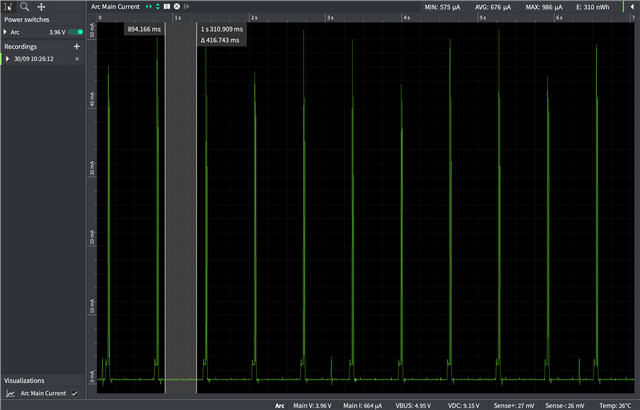Hi!
I have a Thingy:91 v1.6.0 and doing some current measurement on the device.
I've disconnected the LiPo cell, and feed the Thingy from an Otii connected to the P3 (Li-po) connector using 4.0v.
The Thingy is then connected via JTAG cable to a nRF9160DK (for FW upload).
The unit is successfully registered in the nRF Cloud, and sends and works as expected.
When measuring the Thingy current consumption I see regular current spikes (all the time) reaching ~40mA coming every ~630ms, this on top of an idle current of ~650uA, this is with your FW example from the asset_tracker_v2 fetched from your download site (nrf9160dk_fw_2022-06-02_880c82db.zip).
All current measurements are done with the JTAG cable disconnected.
Is this to be expected?
After reading other similar cases here I've tried out a few tings:
I have tested a FW version with "switching off" the nRF9160 by putting in a main program like this:
void main(void){ NRF_REGULATORS->SYSTEMOFF = 1; for(;;){}}
and then I see an idle current of 15-20uA, so the I assume both HW and other sensors on the Thingy should be fine.
I also have built a FW based on the asset_tracker_v2 (with SDK2.0.0), and with the overlay-low-power.conf when building.
Then I measure some 275uA idle current, but still the 40mA spikes every 630mS continues (see attached Otii picture).
Do you know what is causing these current spikes?
In addition to the overlay-low-power.conf I've put an additional config, the purpose is to disable GPS and enable PSM:
# Turn off all GPS stuffCONFIG_NRF_CLOUD_PGPS=nCONFIG_NRF_CLOUD_AGPS=nCONFIG_LTE_NETWORK_MODE_LTE_M_GPS=nCONFIG_DATA_SAMPLE_GNSS_DEFAULT=nCONFIG_APP_REQUEST_GNSS_ON_INITIAL_SAMPLING=nCONFIG_GNSS_MODULE=n# Set activeCONFIG_DATA_DEVICE_MODE=y# Set sample rateCONFIG_DATA_ACTIVE_TIMEOUT_SECONDS=600CONFIG_DATA_MOVEMENT_RESOLUTION_SECONDS=60CONFIG_DATA_MOVEMENT_TIMEOUT_SECONDS=1200CONFIG_DATA_ACCELEROMETER_THRESHOLD=10# Power saving timersCONFIG_LTE_PSM_REQ_RPTAU="00000110"CONFIG_LTE_PSM_REQ_RAT="00000000"
The PSM timer values are fetched from your Online Power Profiler.
Any directions of advice in order to reduce power consumption would be appreciated!
Thanks!

-Alf


